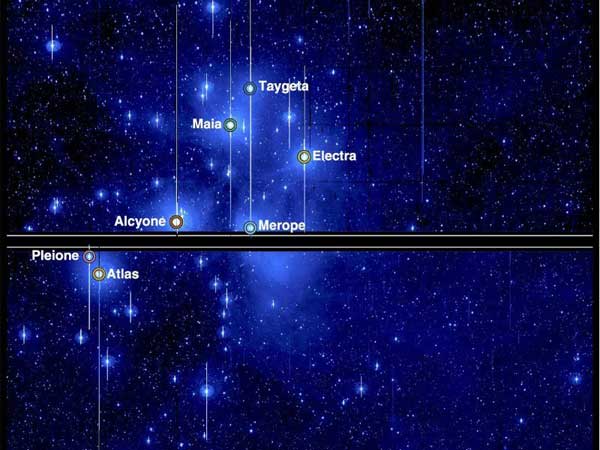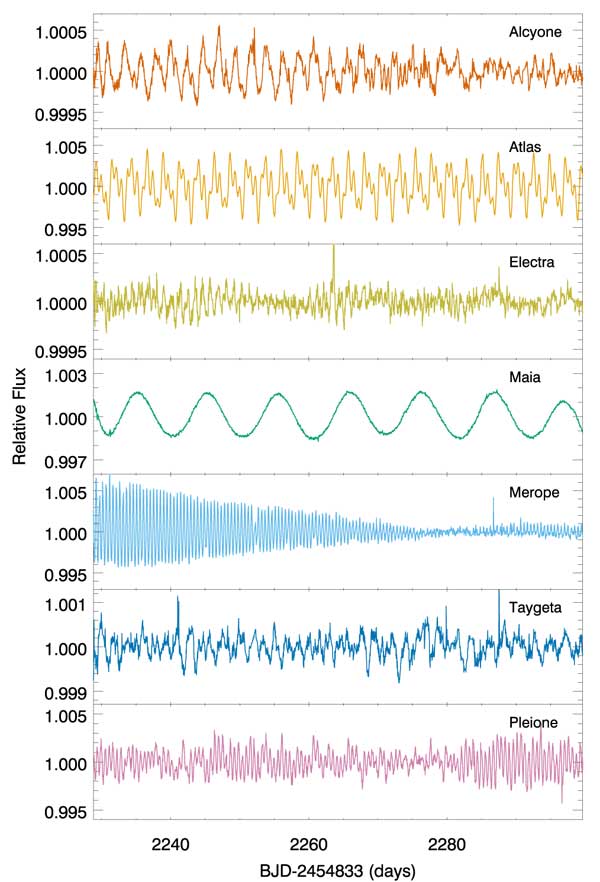The winking stars of the Pleiades are easy targets for backyard observers. They’re also frequent targets for professional ground-based telescopes, polarimeters, and interferometers. So it’s ironic that they’re some of the most difficult targets for sophisticated space-based telescopes.

Davide De Martin & ESA / ESO / NASA Photoshop FITS Liberator
Nowhere is that more true than for Kepler. The exoplanet-hunting satellite has monitored thousands of stars, but the brightest ones have largely remained out of its reach. Now, astronomers have come up with a new technique to change that.
Engineers designed Kepler’s sensitive CCD cameras to catch minute changes in faint stars, in order to detect the tiny blips in light that indicate a planet transiting its sun. But that exquisite sensitivity means that Kepler has difficulty measuring brilliant stars such as Alcyone, Atlas, Electra, Maia, Merope, Taygeta, and Pleione — the “seven sisters” of the Pleiades.
CCD cameras work by capturing photons in “wells,” with each well corresponding to a single pixel in the resulting image. If a plethora of photons come in, the well may overflow, “bleeding” into neighboring wells.

NASA / Aarhus University / T. White
Such bleed trails make it difficult to measure the brightness of a star, because the recorded photons aren’t all in one place. Matters are complicated by the fact that Kepler is in space, so it has a limited amount of time to downlink data via ground stations. To minimize the data it has to send to Earth, the spacecraft only sends information in a “postage stamp” around each star it’s monitoring. There simply isn’t the bandwidth to send down information from a full bleed trail.
Halo Photometry
In the November issue of the Monthly Notices of the Royal Astronomical Society, Timothy White (Aarhus University, Denmark; Georg-August University Gottingen, Germany; and Max Planck Institute for Solar System Research, Germany) and colleagues have come up with a way around Kepler’s limitations: an innovative method called halo photometry.
Rather than looking at the saturated pixel that represents the star itself, the method measures brightness using the scattered light around this central pixel. From this “halo,” the astronomers could reliably measure how bright stars varied over time.
“The halo method will be a definite asset for observing bright stars,” says Austin Gulliver (Brandon University, Canada), who was not involved in the study.
The brilliant stars we see in the Pleiades cluster are blue giant stars — they’re all brighter and more massive than the Sun, and nearing the end of their short lives. And the Kepler observations reveal that they all pulsate, slowly varying in brightness by less than 1%.

White, T. et al. Monthly Notices of the Royal Astronomical Society, 2017 November 1
Weird and Wonderful Maia
But one of these stars is not like the others.
Maia was already known as a mercury-manganese star: its slow rotation and calm atmosphere allow unusual concentrations of heavy elements to circulate near its surface. The Kepler observations revealed that Maia varies on an unusually long period, brightening and fading over a period of 10 days. Combined with ground-based spectroscopy and interferometry, the Kepler data also show that we likely see Maia equator-on. White and colleagues determined that the variability must come from large spots enriched with chemicals on the star’s surface.
“If the spot is fixed on the stellar surface, then it probably has some relation to the magnetic field present,” Gulliver remarks, adding that more data is needed to learn why and how these chemical spots would exist. “Maia should be further investigated using Doppler imaging techniques over several years to better characterize the spots.”
Witnessing these small surface changes is crucial to understanding stars, especially the interiors that are otherwise out of observational reach, Gulliver adds. The sloshing plasma that leads to the brightness pulsations that Kepler detects can tell astronomers what’s happening inside stars. “There is much that we have yet to understand about the physics of stellar cores.”
 3
3









Comments
Peter Wilson
September 19, 2017 at 1:59 pm
Those light-curves are really helpful in showing how the character of variation is distinct for each star! Thanks
You must be logged in to post a comment.
September 20, 2017 at 11:04 am
Yes, I agree. The plots give a feel for the personality of each of the sisters. Just like a human family and its' multiple personalities. This will enhance my future viewings and cause me to linger a bit longer. Thank you.
You must be logged in to post a comment.
September 22, 2017 at 5:41 pm
Can someone quickly describe what's happening with Merope? My naive guess is that it spins really fast to give the rapid dark-light oscillations, and something is slowly occluding it to shape the larger envelope. So I would expect the amplitude of the oscillation to increase again, beyond the right of the graph.
What is really causing it?
You must be logged in to post a comment.
You must be logged in to post a comment.